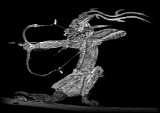
Asian Traditional Archery Research Network
(ATARN)
Click a language for machine
translation ![]()

Background
The Asian Traditional Archery Research Network provides for mutual friendly exchange and support among the different archery traditions of Asia, and to widen appreciation worldwide of the different archery traditions of Asia.
The archery traditions of Asia (for example those of Mongolia, China, Korea, Tibet and Japan) have at one time or another enjoyed cross-fertilization and exchange of techniques (albeit sometimes on the battlefield.) Now some of these great traditions have disappeared, while others flourish, but in isolation.
The archery traditions of Asia are rich in folklore, history, artistic expression, philosophy, technique, science and technology. Some, however, are in danger. In some Asian regions, the influence of western materialistic culture threatens to cause a loss of interest among potential new exponents. Sometimes, it is the craft of the bow and arrow makers which is under threat because of the dying-out of skills or the disappearance of sources of traditional materials.
Activities
The network carries out the following activities -
Historical, folkloric, artistic, technical or military research on traditional Asian archery forms, with particular emphasis on
publishing articles and research papers;
editing and keeping in print rare or ancient classical works relating to important aspects of Asian archery traditions;
collating a bibliography of materials and index of anthropological or archaeological collections to assist in research on Asian traditional archery;
monitoring sources of materials required for the manufacture of traditional archery products;
holding meetings for discussion, exposition or exchange concerning the archery traditions of Asia;
soliciting funding to support the activities of the Network;
making representations to Governments and international organization on any issues which might prejudice the maintenance or development of national or local archery traditions.
Participation
'Traditional Archery' typically describes traditions of military, hunting or target shooting with a bow or crossbow, shooting arrows, stones or other projectiles, and using implements made by traditional crafts-people, or made with a modern, industrial process, but using traditional designs.
'Archery traditions' do not necessarily correspond to sovereign state political units. Membership of the network has no political significance. 'Asia' should be interpreted in a broad sense.
Participants in the network can be proponents of a traditional archery form, or any school of it, or craftsmen, or researchers. There are no nationality, racial, age or sex limitations on participation.
Last up-dated 24 June 2003